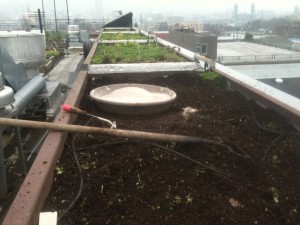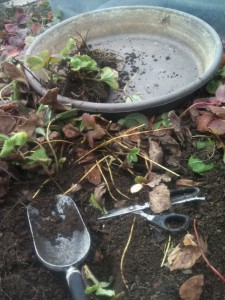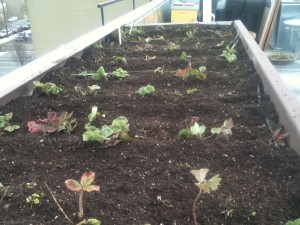Yesterday was a fine day, in fact I’m calling it the “First Day of Spring”! Now that appellation is somewhat arbitrary around here, given that spring-like conditions will come and go for some months, but as I was working on the rooftop I took off my heavier jacket and woolen shirt and actually felt comfortable in a light cotton shirt (still long-sleeved, not quite t-shirt weather yet), and given that there are more sunny, 50+ days in the forecast, I’m jumping in. Happy Spring, everyone!
Spring is a joyous event, but it also means the gardener’s life starts to get busy. Yesterday on the roof there was garlic to weed and fertilize (with feathermeal), chickweed to pull up (in the last post when I said weeds weren’t a problem, I didn’t mean we were completely weed free), and strawberries to transplant.
I first learned of day-neutral strawberries some years ago, and I have been appreciating them more and more ever since. Here in Oregon, we are known for our non-day-neutral, June-bearing strawberries, plants that sense the lengthening days of spring and respond with a flush of flowers, followed by berries that ripen from mid-June to early July. Then that’s it until the following year. It’s great if you want to freeze, can, or in any other way process the berries because they all come on more or less at once. But if you just want to eat fresh strawberries as a snack, then you’re probably going to get mighty sick of them by the end of June and then crave them the whole rest of the year. Enter day-neutrals. Unlike their June-bearing brethren, the lengthening days of spring give them no cause for alarm, and they start going about their business of producing strawberries in late spring and then continue until fall. It’s a tortoise/hare phenomenon. Day-neutrals are in it for the long run, popping out a berry or so per plant each day, and continuing for the whole season. Because of this they are well suited to restaurant, where the strawbs. are mainly going to be used fresh in desserts and such. It’s also great at home, where you can regularly make your breakfast cereal bowl actually look like what’s depicted on the box. At the Noble Rot we use Tristar, a really hard working little berry that’s big on juicy flavor. It is a little smaller than those hulking, cardboardy strawberries that you get from Cal., but if a strawberry tastes like cardboard, is there any merit in its being big? I swear that while eating Tristars on a sunny day, you can actually taste the solar rays, somehow gathered into an even greater perfection. Astonishing!
One of the great things about strawberries is that they make lots of copies of themselves. So much so, that I am obliged to clean out the bed every second year or so, which also gives me a chance to refertilize and respace. I dig them up completely, which is very easy to do, give them a shave and a haircut (trim dead leaves, runners, and cut back the roots a bit), then replant them into a weeded and fertilized bed. In the process you can gather all the babies made last year and either transplant them or give them away to friends, making you a very special Valentine at this time of the year.
Here they are in their new bed, like precious little kindergarteners just toddling off to begin their school days. But these berries won’t take long to complete their studies of their new home and go right to work, and work they will, all the way through fall’s first frost…but who’s thinking about fall and frost….it’s SPRING!



